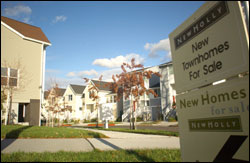In the mid-1990s, the Seattle Housing Authority (SHA) embarked in a radical new direction by participating in the federally funded HOPE VI redevelopment program. Not only was the city’s largest provider of low- income housing going to remake its big projects by tearing them down and creating new mixed-income communities, with market-rate homes alongside its subsidized rental units, but the quasi-governmental agency was going to act as the developer. Whereas once the SHA talked mostly about things like rent subsidies and at-risk populations, it began to speak about its New Urbanism architectural designs for homes featuring hardwood floors and slate entryways.
Now, however, the housing authority is “shifting gears,” in the words of its deputy executive director, Al Levine. It will no longer develop its for-sale properties itself. Instead, it is selling land to private developers who will build those properties and reap whatever profits come from them. The agency is finishing negotiations with developers for still- to-be-built sections of New Holly, the redevelopment that sprung from the Beacon Hill project known as Holly Park. SHA will then negotiate with developers for two other projects undergoing transformationRainier Vista in the Rainier Valley and West Seattle’s High Point. Between all three projects, private developers are slated to build up to 1,400 homes, opening up a coveted opportunity for new construction in a city that is mostly built out. “There hasn’t been anything like this in decades,” says Frank Bosl of CB Richard Ellis, the brokerage that is connecting SHA with developers.
“We think we’ll do better financially this way,” explains SHA’s Levine. Because the cost of building homes proved more expensive than envisioned, he says, the agency was only making between $10,000 and $20,000 on each one. By selling the land, the SHA should at least double its return. Levine and other SHA officials say that’s important because, at a time when the federal government is cutting housing funds, profits from for-sale properties are necessary to subsidize the dramatically upgraded low-income housing and overall infrastructure of these redevelopments.
WILL WE BE SEEING a big change in their look and feel? While these redevelopments are controversial due to concerns over gentrification, New Holly set a high aesthetic standard that has been crucial in turning a once-stigmatized project into a neighborhood populated by professionals as well as the poor. New Holly’s homes, including the low-income rental units, are tasteful affairs worthy of any neighborhood in town, with front porches, sloping roofs, and picture windows. In the forefront of HOPE VI projects nationally, SHA felt it had something to prove in this controversial development, and it shows.
The agency insists it will demand the same high standards of private developers. Acting, it says, like the typical master-plan developer, SHA will use property contracts and legal instruments that travel with deeds to maintain oversight of design and implementation of construction. Still, the use of private developers seems a bit of a wild card. There will certainly be some differences, because in using not just one developer but several at each site, the SHA intends to create more diverse housing styles that will broaden their appeal.
While sales at New Holly’s Phase I took off, they have been just “OK” at Phase II, according to Levine. He attributes that to the uniformity of the product offered: all three-bedroom town houses, as opposed to the mix of attached and detached homes sold in the prior phase. He concedes that the prices are also a sticking point. They range from about $250,000 to $280,000, perhaps not a lot for a town house in Fremont but at the upper end of the market in the South End.
Those prices are especially steep when you consider that HOPE VI was sold politically on the premise that these redevelopments would give low-income public-housing tenants an opportunity to buy homes. The lower end of the price scale is designed to meet affordable-housing guidelines, but they are aimed at households earning as much as 80 percent of the county’s median income. SHA tenants earn no more than 30 percent of the median income. And even for those at 80 percent, the homes are a stretch. “Quite frankly, if you run the numbers, it’s really difficult to qualify” for home financing, says Charles Fulcher, one of a team of Windermere agents selling at New Holly. Sitting in an open-plan kitchen/dining room of one of the town houses, he does some quick calculations. To get financing for this home, priced at $265,000, a household would have to earn at least $60,000 a year. For the typical two-person household interested in these town houses, 80 percent of the median income is $45,200.
HOPE VI’S GREATEST local critic, John Fox of the Displacement Coalition, worries that in turning land over to private developers, the SHA is moving even farther from its mission of providing low-income housing. But the homes built by developers might just be cheaper. The SHA contends that private developers can build less expensively by avoiding the bureaucratic paperwork required of a public agency. Private developers also have long-standing relationships with subcontractors who give them a good deal.
The fact is, the SHA was already transferring its land into private handsto the homeowners who bought into New Holly and who will buy into its other projects. Now it’s getting its cash up front, and more of it.








